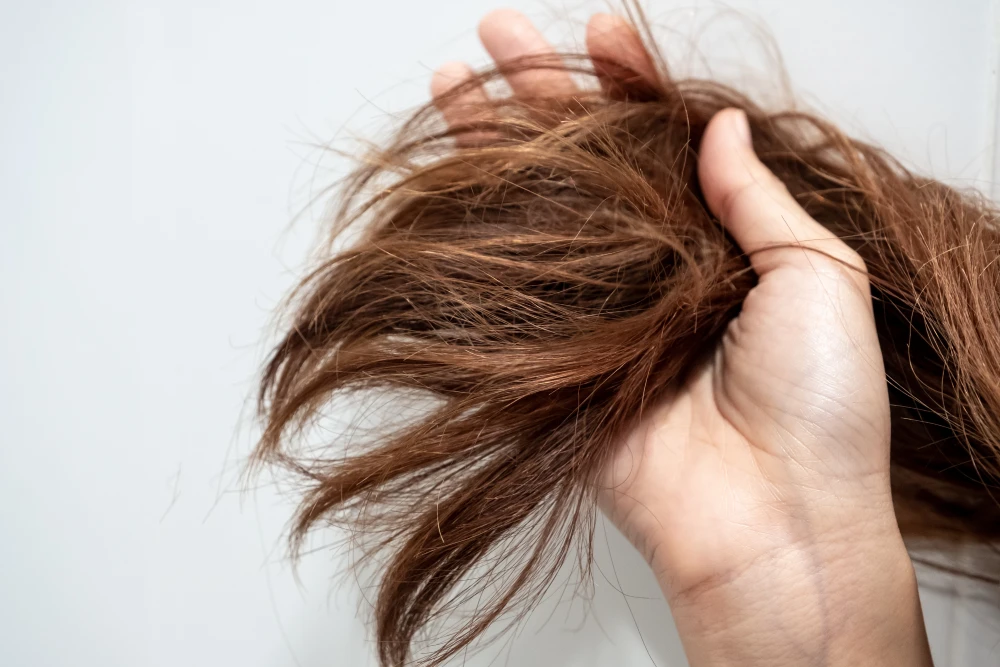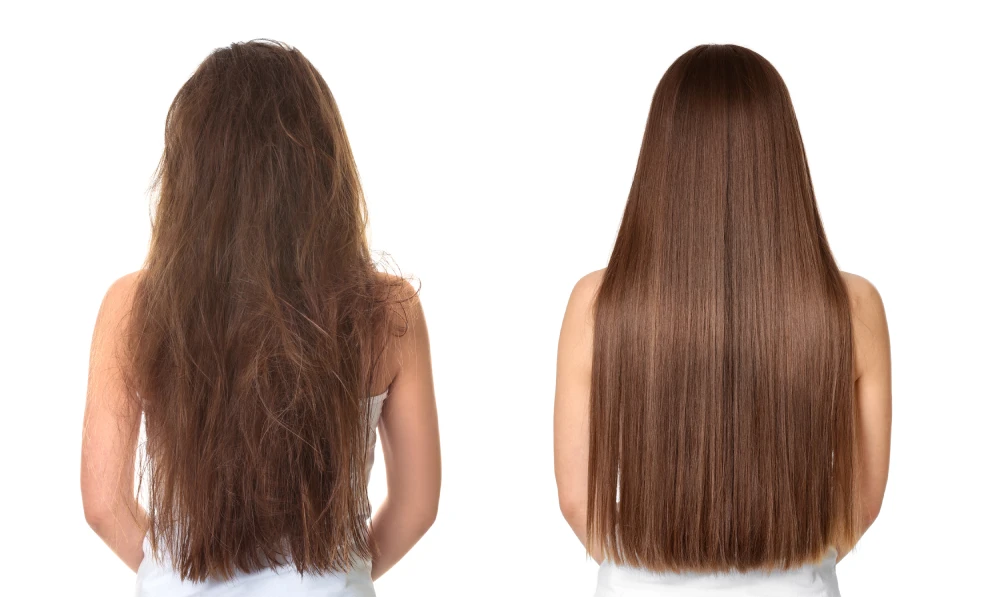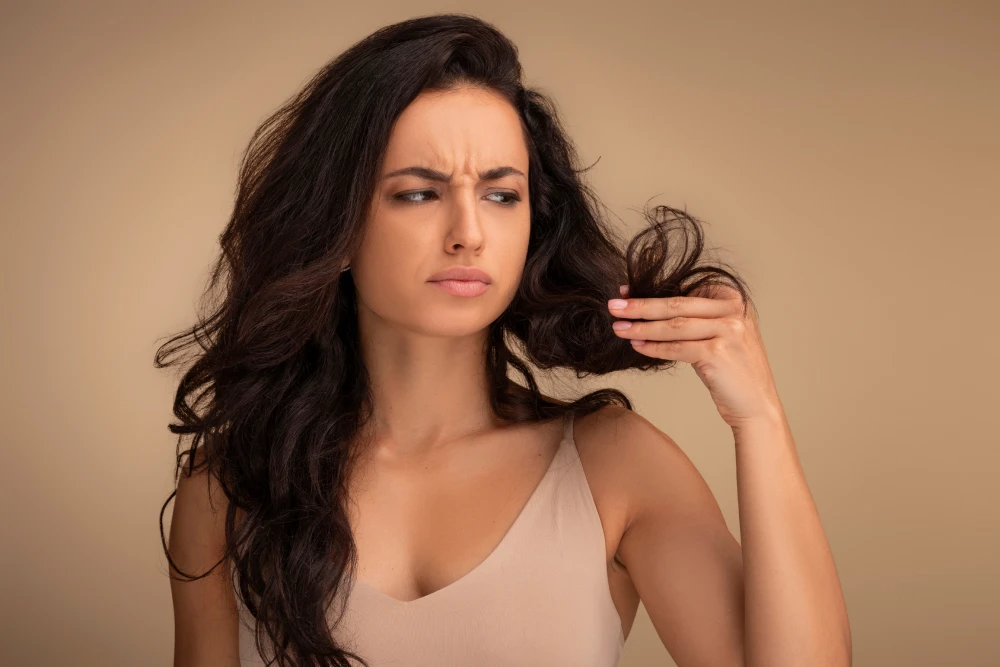Hair is more than just strands—it’s identity, mood, and power. But here’s something most people don’t realize: hair doesn’t just get “tired” or “messy.” It gets damaged on a cellular level, and the signs—frizz, breakage, dullness—are your strands screaming for help.
Heat styling, chemical treatments, even the way you towel-dry—it all chips away at your hair’s strength. The good news? Hair damage isn’t permanent doom. With the right damaged hair treatment and consistent moisturizing hair repair, you can restore shine, strength, and softness. Think of it less as a cover-up and more as rehabilitation for your locks.
At House22 Chicago Spa & Hair Salon, hair repair is treated like artistry. From hair bonding treatments to deep conditioning rituals, these services bring strands back from the brink.
Dive deeper to find out more about the causes of hair damage and the treatments that actually fix them.
What Is Hair Damage?
Hair damage happens when the protective cuticle layer—the shield around each strand—gets cracked or lifted. Once that barrier is compromised, moisture escapes, protein breaks down, and strands lose their smooth surface. That’s when you see frizz, tangles, and breakage.
Damaged hair isn’t just about looks—it feels different too. Rough to the touch, weak when pulled, lifeless instead of bouncy. But the good news is, damage doesn’t mean dead ends. Modern hair breakage repair and split end solutions can rebuild strength and restore hydration, bringing strands back to life.
Top 10 Causes of Hair Damage
Damage doesn’t just happen overnight—it builds up from daily habits, lifestyle choices, and environmental factors. Understanding the main culprits is the first step toward choosing the right damaged hair treatment and repairing your strands back to strength.
1. Heat Styling Overload
Flat irons, curling wands, and blow dryers can reach temperatures higher than 400°F. At that level, the keratin proteins in your hair literally break down, and natural oils evaporate. What’s left are brittle, weak strands that lose their bounce.
Occasional heat is fine, but using these tools daily without protection leaves hair screaming for hair breakage repair.
2. Chemical Processing
Bleaching, coloring, perms, and relaxers work by breaking down the hair’s internal bonds to reshape or lighten it. While the transformation can be stunning, it strips hair of its natural strength and moisture.
Over time, strands become porous, frizzy, and prone to split ends. Without follow-up deep conditioning or hair bonding treatments, chemically processed hair won’t hold up.
3. Over-Washing
Cleansing your scalp is important, but shampooing too often strips away the natural sebum that keeps hair soft and flexible. For people with fine or oily hair, it’s tempting to wash daily, but this cycle can make the scalp produce even more oil, while the strands themselves dry out.
The result? Ends that feel straw-like and break easily, making moisturizing hair repair treatments essential.

4. Lack of Moisture
Think of hair as a fiber. When it’s hydrated, it bends and moves; when it’s dry, it cracks and snaps. Environmental stressors like sun exposure, cold weather, or even constant indoor heating pull moisture out of strands, leaving them dull and rough.
Without regular hydrating masks or moisturizing hair repair rituals, this dehydration accelerates visible damage and frizz.
5. Rough Handling
How you treat your hair matters as much as what you put on it. Brushing aggressively, detangling when it’s soaking wet, or pulling hair into tight ponytails and buns can cause mechanical stress.
This leads to weakened cuticles, breakage, and traction alopecia over time. Simple swaps—like silk pillowcases, gentle detangling, and split end solutions—can dramatically reduce this kind of wear-and-tear damage.
6. Environmental Damage
Your hair faces the elements every day. UV rays break down keratin and fade color, wind causes tangles and breakage, and pollutants cling to strands, dulling shine. Chlorine and saltwater are also major offenders, stripping hair of its protective oils.
Over time, this creates rough texture and limp, lifeless locks that crave hair strengthening and deep conditioning rescue.
7. Nutritional Deficiencies
Your hair’s health is directly tied to what you eat. Protein, vitamins like Biotin and B12, and omega-3 fatty acids are all building blocks for strong, shiny strands. Skimp on these, and hair becomes thin, brittle, and prone to shedding.
Pairing a balanced diet with a protein hair mask can replenish lost nutrients and rebuild resilience from the inside out.
8. Stress and Hormonal Shifts
Stress hormones like cortisol wreak havoc on your body—including your scalp. Chronic stress can shorten the hair growth cycle, leading to excessive shedding and thinning. Hormonal changes during pregnancy, postpartum, or menopause can also alter oil production and hair texture.
When this happens, strands need more targeted damaged hair treatment to stay balanced and strong.
9. Product Buildup
Styling products like gels, sprays, and creams can create a layer of residue that suffocates strands and clogs the scalp. Over time, this buildup repels moisture and nutrients, leaving hair dull and flat no matter how much conditioner you pile on.
Clarifying washes paired with moisturizing hair repair treatments can reset your strands and help them absorb what they need again.
10. Skipping Regular Maintenance
Ignoring trims and skipping salon-grade treatments is like never servicing your car—you might get away with it for a while, but eventually, things break down. Split ends creep higher, breakage spreads, and overall health declines.
Regular trims paired with hair bonding treatments and deep conditioning rituals prevent small issues from turning into full-on damage.
What Is Hair Repair?
Hair repair isn’t just slapping on conditioner and hoping for the best—it’s a strategy. True damaged hair treatment focuses on rebuilding your strands from the inside out, tackling weakness at the structural level instead of simply coating it with shine.
When hair is damaged, the cuticle is lifted, the bonds inside are weakened, and the strand becomes porous. That’s why you see split ends, frizz, and breakage—it’s literally your hair crying out for help.
Modern hair repair treatments are like rehab for your strands. Options like hair bonding treatments rebuild broken bonds, protein hair masks strengthen keratin, and deep conditioning rituals flood hair with moisture to restore softness.

Pair that with moisturizing hair repair products, and you’re not just faking healthy hair—you’re retraining it to act strong and resilient again. Repair is also about prevention. Consistent care creates a shield that protects against future heat, chemical, and environmental damage.
Think of it as defense and offense: you’re fixing what’s broken while setting your strands up to handle tomorrow’s stress.
In short, hair repair isn’t cosmetic—it’s transformational. It takes your hair from fragile and fried to silky, strong, and full of life again.
Final Thoughts
Hair damage is real, but it’s not forever. From heat styling to environmental stress, your strands go through a lot. But with the right hair repair treatments—from split end solutions to deep conditioning rituals—you can rebuild strength, restore shine, and protect your locks from future damage.
At House22 Chicago Spa & Hair Salon, Chicago, IL, hair repair is more than a service—it’s a transformation. Because healthy hair doesn’t just happen, it’s created. And when it does? The confidence is undeniable.
What are you waiting for? Get in touch with us today to schedule your consultation!

